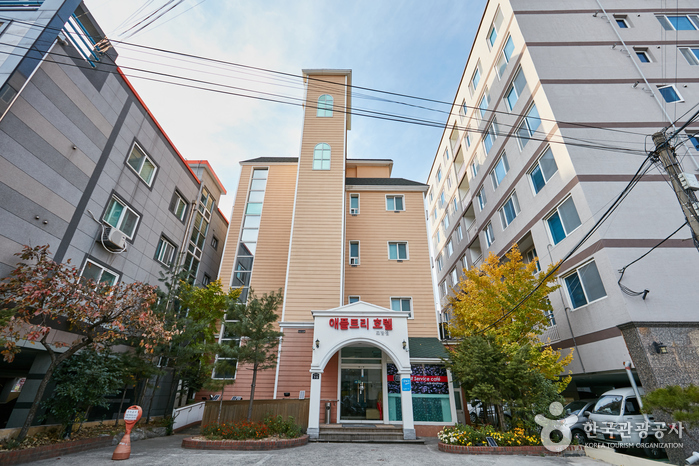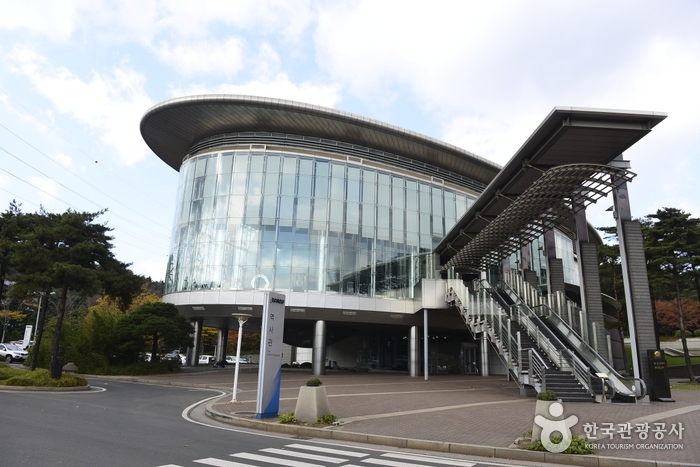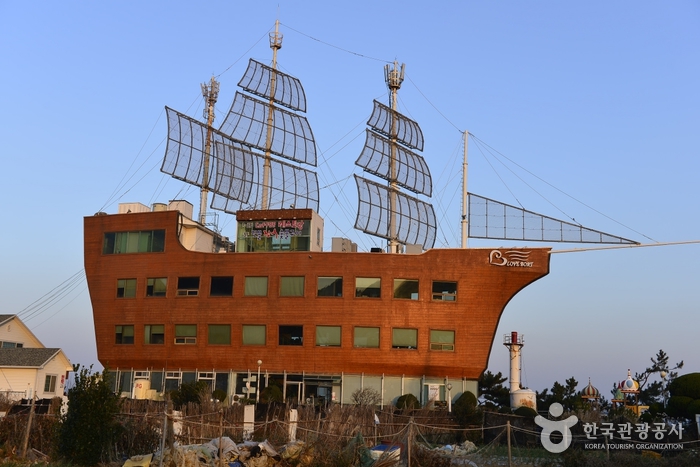Appletree Hotel
7.0 Km 17634 2021-04-09
7-5, Jungheung-ro 100beon-gil, Nam-gu, Pohang-si, Gyeongsangbuk-do
+82-54-241-1234
Apple Tree Hotel is a business hotel located in Pohang, Gyeongsangbuk-do. It's a five-story building with a total of 28 Double, Twin, and Ondol Rooms. Non-smoking rooms are available, and free breakfast is served from 7:00am to 9:00am. The hotel is a mere 5-minute walk from Pohang Bus Terminal and only a 10-minute ride from Pohang Airport. Nearby tourist attractions include Guryongpo and Homigot Sunrise Square. The most famous dish in Pohang is "Guryongpo Guamaegi,” which is half-dried mackerel pike or herring.
Terminal de Bus Interurbain Pohang
7.2 Km 41387 2016-05-27
579-13 Sangdo-dong Pohang-si ongsangbuk-do
POSCO (포스코 포항제철소)
7.7 Km 3859 2018-09-05
Dongchon-dong, Nam-gu, Pohang-si, Gyeongsangbuk-do
L’aciérie de Pohang a été créée au début des années 80 dans la baie de Yeongilman avec l’objectif de rompre avec l’industrie des années 60 centrée sur l’agriculture et ainsi lancer la zone dans l’industrie chimique lourde. La construction de l’aciérie a duré de 1970 à 1981. Au centre historique de POSCO, les visiteurs peuvent apprendre le fonctionnement d’une aciérie et comment POSCO est devenu l’une des entreprises les plus compétitives dans le monde en deux décennies. La visite en bus de l’aciérie devient un parcours de visite populaire auprès des visiteurs d’affaires.
Musée POSCO (포스코 역사관)
7.8 Km 2408 2019-03-26
14, Donghaean-ro 6213beon-gil, Nam-gu, Pohang-si, Gyeongsangbuk-do
+82-54-220-7720~1
Le Musée POSCO montre l'histoire, l'esprit, la culture d'entreprise et la vision de Posco.
Dans les pays avancés, il n'est pas rare pour une entreprise privée d'ouvrir un musée, cependant, il est une rareté dans l'expérience coréenne. Par conséquent, le Musée POSCO est venu sur la scène depuis le début de la planification de maître. Le musée a été créé dans le but d'être "un musée dans lequel le passé", présent et futur coexistent POSCO, connaître l'histoire de succès et de grandes réalisations de POSCO, qui est devenu un leader mondial de l'industrie depuis sa création en 1968.
Robot Life Museum (로보라이프 뮤지엄)
8.7 Km 1244 2019-03-26
39 Jigok-ro, Nam-gu, Pohang-si, Gyeongsangbuk-do
+82-54-279-0427
Le musée Robot Life Museum est situé au rez-de-chaussée de l’institut de recherche coréen sur la robotique. Il abrite une exposition et un hall d’activités sur l’intelligence robotique, un hall promotionnel KIRO, un café robot et une salle d’éducation sur l’intelligence robotique. Les visiteurs peuvent y découvrir la manière dont l’intelligence artificielle peut améliorer les logements de demain, ainsi que le futur de l’environnement robotique. De nombreuses activités permettent aux visiteurs de découvrir les nombreuses fonctionnalités des robots d’aujourd’hui et de demain.
Aéroport de Pohang Gyeongju (포항경주공항)
9.9 Km 9341 2022-08-18
18, Ilwol-ro, Donghae-myeon, Nam-gu, Pohang-si, Gyeongsangbuk-do
+82-1661-2626
L'aéroport de Pohang situé dans le quartier donghae-myeon de
Pohang-si (Gyeongsangbuk-do) se trouve à 11.5 km de l'hôtel de ville de
Pohang et à 5 km de Guryongpo. Renouvelé en juin 2002, l'aéroport
abrite désormais un grand espace consacré au parking et diverses
installations. L'aéroport peut opérer jusqu'à 100 000 vols et faire
transiter 1 870 000 passagers par an. Ses zones de stationnement peuvent
accueillir jusqu'à 530 appareils.
Sarangui Yuramseon, Restaurant (사랑의유람선)
10.7 Km 2267 2021-10-06
1804, Haean-ro, Buk-gu, Pohang-si, Gyeongsangbuk-do
+82-54-262-7777
As you drive along the fantastic course from Chilpo to Wolpo, you will find a big sailing ship turned into a restaurant.
Sarangui Yuramseon, which means the ‘love boat’, takes pride in its beautiful, wooden and boat-shaped architecture, and the breathtaking view.
In fact, it is a well-known spot for about-to-be-married couples to take their wedding photos.
At Sarangui Yuramseon, the modern interior, accompanied by the fascinating melodies of a jazz piano, creates an exquisite atmosphere.
Note also that each season they provide a special event for their customers.
You won’t need to go to a five-star hotel to experience fine dining.
You can simply enjoy the excellent food and the impeccable service at Sarangui Yuramseon.
Observatoire de l'ancre Igari (이가리 닻 전망대)
13.4 Km 0 2023-02-06
Iga-ri, Cheongha-myeon, Buk-gu, Pohang-si, Gyeongsangbuk-do
L'observatoire de l'ancre Igari, situé à Igari (ville de Pohang), désigne un observatoire qui a la forme d'une ancre et accueille les navires près de la magnifique station balnéaire d'Igari connue pour ses pins. L'obsercatoire mesure 10 m de haut pour 102 m de long, c'est un endroit où vous pouvez profiter d'une vue panoramique sur la mer de Pohang. Il s'agit également d'un endroit populaire pour de nombreux touristes qui viennent redécouvrir ce lieu de tournage du fameix drama Run On diffusé sur la chaîne JTBC.
Hyangdan [Korea Quality] / 향단 [한국관광 품질인증]
14.6 Km 42643 2020-09-08
121-83, Yangdongmaeul-gil, Gangdong-myeon, Gyeongju-si, Gyeongsangbuk-do
+82-10-6689-3575
Hyangdan House (Treasure No. 412) is located in the famous village of Yangdong (Gyeongju City), which has been designated as National Folklore Cultural Heritage No. 189 and recognized as a Historic Village of Korea, and consequently listed as a UNESCO World Heritage Site. The head houses of the Gyeongju Son clan and the Yeogang Yi clan are situated in this traditional village, along with typical hanok houses of Joseon noblemen and the thatched houses of commoners. Among the houses in the village, Hyangdang House stands out as it is located around Mulbong Hill. The house was built in 1540 by King Jungjong (r. 1506-1544) for the mother of Yi Eon-jeok (pen-name: Hoejae, 1491-1553). It originally measured 99-kan (a unit of measurement referring to the distance between two columns), but part of the house was destroyed during the Korean War (1950-53), leaving only 56-kan of the original structure. Hyangdan House was built in close harmony with nature, so its structure is distinct from that of other hanok houses. As it was built on a slope, the x_heights of its various structures differ considerably. For instance, the daemungan (gate building) of the haengrangchae (servants’ quarters) was built by placing the foundation stones on the incline and then building the gate on top of them. In particular, there are no staircases leading up to the main gate at the front, but there is a side door adjacent to the gate through which one can enter the house. In addition, the sarangchae (men’s quarters) located behind the haengrangchae on the higher ground can be reached via the staircases. The other structures, such as the kitchen, anchae (women’s quarters), and geonneonbang (a room opposite the main living room) are located at different levels, protecting them from exposure to the outside. Therefore, thanks to the high position of the house, it is luminous and commands an excellent view. Furthermore, the anchae is situated in the middle of the house, which enables the occupants to reach the rest of the house easily. The anbang (main living room) connects to the daecheong (main floored room) toward the south. Hyangdan House runs a variety of experience programs such as a woodblock printing program in which participants can write a letter using woodblock printing on hanji (traditional Korean paper handmade from mulberry tree); a traditional etiquette program including the wearing of hanbok (traditional Korean clothes); a tea ceremony with lotus tea; and a natural dyeing program in which participants learn how to use natural materials to dye fabric (bag, clothes, etc.). It is recommended to book the desired experience program when reserving a room at the guesthouse. The house comprises four guestrooms in the anchae, three rooms in the additional building (busokchae), and two rooms in the haengrangchae, all of which are often fully booked.
Village Traditionnel Yangdong [Patrimoine mondial de l'UNESCO] (경주 양동마을)
14.7 Km 18816 2023-01-13
134, Yangdongmaeul-gil, Gangdong-myeon, Gyeongju-si, Gyeongsangbuk-do
+82-54-762-2630
Le Village Traditionnel Yangdong à Gyeongju est le plus grand village traditionnel de Corée, affichant la culture de la Dynastie de Joseon et la beauté naturelle des environs. Grâce à ses nombreux héritages culturels, incluant des trésors, des trésors nationaux et des matériaux folkloriques, le village entier fut désigné en tant que site d’héritage culturel. De nombreuses personnes ont visité ce village pour voir la profusion de ces derniers ainsi que ses environs pittoresques. Le Prince Charles l’a visité en 1993.
Le mont Seolchangsan et ses quatre pics peuvent être aperçus derrière le village. Approximativement 160 maisons anciennes, et des maisonnettes aux toits de chaume de 500 ans d’âge sont nichées au sein de la vallée. 54 de ces maisons ont plus de 200 ans et ont été excellement préservées dans leur état d’origine, offrant une rare opportunité de voir en personne une variété de maisons traditionnelles coréennes.




![Hyangdan [Korea Quality] / 향단 [한국관광 품질인증]](http://tong.visitkorea.or.kr/cms/resource/07/2579207_image2_1.jpg)
![Village Traditionnel Yangdong [Patrimoine mondial de l'UNESCO] (경주 양동마을)](http://tong.visitkorea.or.kr/cms/resource/44/2654744_image2_1.jpg)
 Français
Français
 한국어
한국어 English
English 日本語
日本語 中文(简体)
中文(简体) Deutsch
Deutsch Español
Español Русский
Русский